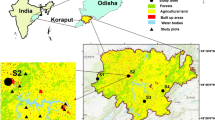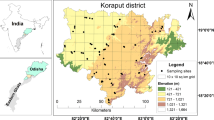Abstract
This paper reports our results of studies connected with the energy flow in earthworm populations in an upland and a lowland pasture where grazing by large herbivores were not allowed. The net annual energy input was more than double in the lowand pasture. Flooding during the rainy season caused heavy mortality and migration of worms in lowland pasture. Higher energy consumption through respiration in the upland pasture was due to difference in environmental conditions. Lower amount of secondary production (P) and higher amount of energy utilized in respiration (R) cause an increased R:P ratio in upland pasture. Energy channelization in both the sites has been represented in box type energy flow models. Management of these pasture lands depends on the understanding of the dynamics of energy flow in these systems.
Similar content being viewed by others
References
Barfield A E and Solomon D J 1972 Oxycalorific coefficients for animals respiring nitrogenous substances;Comp. Biochem. Physiol. 43 837–841.
Bouche MB 1971 Relations entre les structures spatiales et functionnelles des écosystèmes illustress par role pedobiologique des Vers de terre. In:La Vie dans les Sois, aspects nouveaux, etudes expérimentales ed) P Pesson, (Paris: Gauthier-Villars) pp. 189–209
Darwin C 1881The formation of vegetable mould through the action of worms, with observations of their habits. (London: Murry) pp. 326
Dash M C 1978 Role of earthworms in the decomposer system. In:Glimpses of ecology (eds) J S Singh and B Gopal (India International Scientific Publication) pp. 399–406
Dash M C and Patra U C 1977 Density, biomass and energy budget of a tropical earthworm population from a grassland site in Orissa, India;Rev. Ecol. Biol. Sol. 14 461–471
Dash M C and Patra U C 1979 Wormcast production and nitrogen contribution to soil by a Tropical Earthworm population from a grassland site in Orrisa. India;Rev. Ecol Biol Sol. 16 79–83
Dash M C and Senapati B K 1980 Cocoon morphology, hatching and emergence pattern in tropical earthworms;Pedobiologia 20 317–324
Engelmann M D 1961 The role of soil arthropods in the energetics of an old field community;Ecol Monogr. 31 221–238
Golley F B 1961 Energy values of ecological materials;Ecology 42 581–584
Hutchinson K J and King K L 1979 Arable grassland consumers In:Grassland ecosystems of the world (ed) R T Coupland (Cambridge: University Press)
Jain S K and Mishra G P 1972 Changes in under ground biomass and annual increment in an upland grassland of Sagar;Trop. Ecol. 13 131–138
Kaplan A 1969 The determination of urea ammonia and urease In:Methods of Biochemical analysis (ed) D Glick (New York: John Wiley) Vol 17 pp. 311–321
Lavelle P 1977 Bilan énergétique des populations naturelles du Ver de terre geophageMillsonia anomala (Acanthodrilidae, Oligochaetes) dans la%savana de Lamto (Cote d Ivoire) 3eColl. Ecol. Trop. Lubumbashi (Zaire), avril 1975;Geo. Ecol. Trop. 1 149–157.
Lavelle P 1978 Ivoire Les Ver de terre de la savana de Lamto, Cote d peuplements, populations et functions dans P ecosystems;Pub. Lab. Zool. E.N.S.12 301
Lavelle P 1980 The Soil Macrofauna of Tropical Savana II. Earthworms In:Ecosystems of the world: Tropical Savana, (Elsevier Publication) (preprint)
Lowry O H, Rosenbrough N J, Farr A L and Randa R J 1951 Protein estimation with the folin ciacalteau reagent;J. Biol Chem. 193 265–272
Macfadyen A 1963 The contribution of the microfauna to soil metabolism In:Soil organisms, (eds) J Doeckson and J van der Drift (Amsterdam: North Holland) pp. 3–17
Macfadyen A 1967 Methods of investigation of productivity of invertebrates in terrestrial ecosystems In:Secondary productivity of terrestrial ecosystems (ed) K Petrusewicz (Institute of Ecology Polish Academy of Sciences), Vol. II pp. 383–412
Moore S and Stein W H 1948 Colorimetric estimation of total free amino acid In:Methods in Enzymology Vol. Ill (eds) S P Colowick and N D Kaplan (New York: Academic Press) pp. 468–471
Nowak E 1975 Population density of earthworms and some elements of their production in several grassland environments;Ekol Pol. 23 459–491
Odum E P 1959Fundamental of ecology 2nd (ed) W B Saunders Philadelphia pp. 573
Petrusewicz K and Macfadyen A 1970Productivity of terrestrial animals: principles and methods. IBP Hand Book No. 13; (Oxford: Blackwell Scientific Publications)
Scatchell J E 1967Lumbricidae In:Soil biology (eds) A Burges and F Raw (London: Academic Press) pp. 59–322
Scatchell J E 1971 Earthworms In:Methods of study in quantitative soil ecology: population production and energy flow (ed) J Phillipson; IBP Hand Book No. 18 (Oxford: Blackwell Scientific Publications) pp. 107–127
Senapati B K 1980Aspects of Ecophysiologicalstudies on Tropical Earthworms Ph.D. thesis submitted to Sambalpur University, Orissa India, pp. 154
Senapati B K, Dash M C, Rana A K and Panda B K 1980 Observation on the effect of earthworm in the decomposition process in soil under Laboratory conditions;Comp. Physiol. Ecol. 5 140–142
Senapati B K and Dash M C 1981 Grazing effect on primary production and oligochaete population of Tropical pasture lands of India;Rev. Ecol. Biol. Sol. 18 487–505
Senapati B K and Dash M C 1982a Functional role of earthworms in the decomposer sub-system.Tropical ecology (in process)
Senapati B K and Dash M C 1982b Energy budget of tropical earthworm populations from an ungrazed and a grazed pasture;Oekologia (Berlin) (in process)
Sims P L and Singh J S 1971 Herbage dynamics and net primary production in certain ungrazed and grazed grassland in North America In:Preliminary analysis of structure and function in grasslands (ed) N R French, Science Series No. 10 Fort Collins Range Science Department pp. 59-124
Watanabe H 1975 On the amount of cast production by the Megascolecid earthwormPheretima hupeiensis;Pedobiologia.15 20–28
Welch P S 1948Limnological methods (New York: McGraw-Hill) pp. 38
Author information
Authors and Affiliations
Rights and permissions
About this article
Cite this article
Senapati, B.K., Dash, M.C. Energetics of earthworm populations in tropical pastures from India. Proc Ani Sci 92, 315–321 (1983). https://doi.org/10.1007/BF03186200
Received:
Revised:
Issue Date:
DOI: https://doi.org/10.1007/BF03186200




